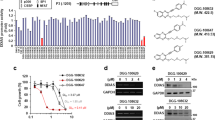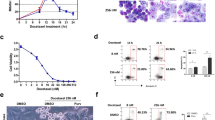Abstract
Livin, a novel member of the human inhibitors of apoptosis protein (IAP) family, plays an important role in tumor progression and occurrence by inhibiting cell apoptosis. It is selectively expressed in the most common human neoplasms and appears to be involved in tumor cell resistance to chemotherapeutic agents. To investigate its possibility as a therapeutic target for human malignancies, we established two genetically different stable tumor cell lines (LoVo and SPCA-1) and RNA interference (RNAi) technique was employed to downregulate Livin expression in two human tumor cell lines. The specific downregulation of Livin expression in tumor cell lines significantly inhibited in vitro cell proliferation and in vivo tumorigenicity. Furthermore, Livin knockdown led to cell arrest in the G1/G0 phase of cell cycle, eventual apoptosis and chemosensitivity enhancement in tumor cells. All these results indicate that RNAi-mediated downregulation of Livin expression can lead to potent antitumor activity and chemosensitizing effects in human cancers.
This is a preview of subscription content, access via your institution
Access options
Subscribe to this journal
Receive 12 print issues and online access
$259.00 per year
only $21.58 per issue
Buy this article
- Purchase on Springer Link
- Instant access to full article PDF
Prices may be subject to local taxes which are calculated during checkout











Similar content being viewed by others
Accession codes
References
Kasof GM, Gomes BC . Livin, a novel inhibitor of apoptosis protein family member. J Biol Chem 2001; 276: 3238–3246.
Ambrosini G, Adida C, Altieri DC . A novel anti-apoptosis gene, survivin, expressed in cancer and lymphoma. Nat Med 1997; 3: 917–921.
Salvesen GS, Duckett CS . IAP proteins: blocking the road to death’s door. Nat Rev Mol Cell Biol 2002; 3: 401–410.
Vucic D, Stennicke HR, Pisabarro MT, Salvesen GS, Dixit VM . ML-IAP, a novel inhibitor of apoptosis that is preferentially expressed in human melanomas. Curr Biol 2000; 10: 1359–1366.
Lin JH, Deng G, Huang Q, Morser J . KIAP, a novel member of the inhibitor of apoptosis protein family. Biochem Biophys Res Commun 2000; 279: 820–831.
Lv J, Chen ZC . Recent research about Livin in cancer. Chin J Cancer Prev Treat 2006; 13: 1347–1350.
Ashhab Y, Alian A, Polliack A, Panet A, Yehuda D . Two splicing variants of apoptosis gene with different biological properties and tissue distribution pattern. FEBS Lett 2001; 495: 56–60.
Yagihashi A, Ohmura T, Asanuma K, Kobayashi D, Tsuji N, Torigoe T et al. Detection of autoantibodies to survivin and livin in sera from patients with breast cancer. Clin Chim Acta 2005; 362: 125–130.
Hariu H, Hirohashi Y, Torigoe T, Asanuma H, Hariu M, Tamura Y et al. Aberrant expression and potency as a cancer immunotherapy target of inhibitor of apoptosis protein family, Livin/ML-IAP in lung cancer. Clin Cancer Res 2005; 11: 1000–1009.
Gazzaniga P, Gradilone A, Giuliani L, Gandini O, Silvestri I, Nofroni I et al. Expression and prognostic significance of LIVIN, SURVIVIN and other apoptosis-related genes in the progression of superficial bladder cancer. Ann Oncol 2003; 14: 85–90.
Liu X, Chen N, Wang X, He Y, Chen X, Huang Y et al. Apoptosis and proliferation markers in diffusely infiltrating astrocytomas: profiling of 17 molecules. J Neuropathol Exp Neurol 2006; 65: 905–913.
Crnković-Mertens I, Muley T, Meister M, Hartenstein B, Semzow J, Butz K et al. The anti-apoptotic livin gene is an important determinant for the apoptotic resistance of non-small cell lung cancer cells. Lung Cancer 2006; 54: 135–142.
Sun JG, Liao RX, Chen ZT, Wang ZX, Zhang Q, Hu YD et al. Gene transfection of Livin isoforms into A549 cell line and its effect on cell growth and sensitivity to chemotherapy and radiotherapy. Zhonghua Jie He He Hu Xi Za Zhi 2005; 28: 836–840.
Chang H, Schimmer AD . Livin/melanoma inhibitor of apoptosis protein as a potential therapeutic target for the treatment of malignancy. Mol Cancer Ther 2007; 6: 24–30.
Kasof GM, Gomes BC . Livin, a novel inhibitor of apoptosis protein family member. J Biol Chem 2001; 276: 3238–3246.
Crnkovic-Mertens R, Hoppe-Seyler F, Butz K . Induction of apoptosis in tumor cells by siRNA-mediated silencing of the Livin/ML-IAP/KIAP gene. Oncogene 2003; 22: 8330–8336.
Uprichard SL . Related articles, the therapeutic potential of RNA interference. FEBS Lett 2005; 579: 5996–6007.
Zamore PD, Tuschl T, Sharp PA, Bartel DP . RNAi: double-stranded RNA directs the ATP-dependent cleavage of mRNA at 21–23 nucleotide intervals. Cell 2000; 101: 25–33.
Wianny F, Zernicka-Goetz M . Specific interference with gene function by double-stranded RNA in early mouse development. Nat Cell Biol 2000; 2: 70–75.
Elbashir SM, Harborth J, Lendeckel W, Yalcin A, Weber K, Tuschl T . Duplexes of 21-nucleotide RNAs mediate RNA interference in cultured mammalian cells. Nature 2001; 411: 494–498.
Dykxhoorn DM, Palliser D, Lieberman J . The silent treatment: siRNAs as small molecule drugs. Gene Therapy 2006; 13: 541–552.
Agami R . RNAi and related mechanisms and their potential use for therapy. Curr Opin Chem Biol 2002; 6: 829–834.
Pulukuri SM, Gondi CS, Lakka SS, Jutla A, Estes N, Gujrati M et al. RNA interference-directed knockdown of urokinase plasminogen activator and urokinase plasminogen activator receptor inhibits prostate cancer cell invasion, survival, and tumorigenicity in vivo. J Biol Chem 2005; 280: 36529–36540.
Liston P, Fong WG, Korneluk RG . The inhibitors of apoptosis: there is more to life than Bcl2. Oncogene 2003; 22: 8568–8580.
Nachmias B, Ashhab Y, Ben-Yehuda D . The inhibitor of apoptosis protein family (IAPs): an emerging therapeutic target in cancer. Semin Cancer Biol 2004; 14: 231–243.
Liu B, Han M, Wen JK, Wang L . Livin/ML-IAP as a new target for cancer treatment. Cancer Lett 2007; 250: 168–176.
Chang H, Schimmer AD . Livin/melanoma inhibitor of apoptosis protein as a potential therapeutic target for the treatment of malignancy. Mol Cancer Ther 2007; 6: 24–30.
Ashhab Y, Alian A, Polliack A, Panet A, Yehuda DB . Two splicing variants of a new inhibitor of apoptosis properties and tissue distribution pattern. FEBS Lett 2001; 495: 56–60.
Crnkovic-Mertens I, Semzow J, Hoppe-Seyler F, Butz K . Isoform-specific silencing of the Livin gene by RNA interference defines Livin beta as key mediator of apoptosis inhibition in HeLa cells. J Mol Med 2006; 84: 232–240.
Crnkovic-Mertens I, Wagener N, Semzow J, Grone EF, Haferkamp A, Hohenfellner M et al. Targeted inhibition of Livin resensitizes renal cancer cells towards apoptosis. Cell Mol Life Sci 2007; 64: 1137–1144.
Wang H, Tan SS, Wang XY, Liu DH, Yu CS, Bai ZL . Effects of siRNA on expression of livin and dose- and time-response in human malignant melanoma LiBr cells. Xi Bao Yu Fen Zi Mian Yi Xue Za Zhi 2007; 23: 741–744.
Crnkovic-Mertens I, Hoppe-Seyler F, Butz K . Induction of apoptosis in tumor cells by siRNA-mediated silencing of the Livin/MLIAP/K1AP gene. Oncogene 2003; 22: 8330–8336.
Lopes RB, Gangeswaran R, McNeish IA, Wang Y, Lemoine NR . Expression of the IAP protein family is dysregulated in pancreatic cancer cells and is important for resistance to chemotherapy. Int J Cancer 2007; 120: 2344–2352.
Yan H, Brouha B, Liu T, Raj D, Biddle D, Lee R et al. Proteolytic cleavage of Livin (ML-IAP) in apoptotic melanoma cells potentially mediated by a non-canonical caspase. J Dermatol Sci 2006; 43: 189–200.
Acknowledgements
We thank everyone in the Department of Clinical Laboratory for their sincere help and excellent technical assistance.
Author information
Authors and Affiliations
Corresponding author
Rights and permissions
About this article
Cite this article
Wang, R., Lin, F., Wang, X. et al. Silencing Livin gene expression to inhibit proliferation and enhance chemosensitivity in tumor cells. Cancer Gene Ther 15, 402–412 (2008). https://doi.org/10.1038/cgt.2008.16
Received:
Revised:
Accepted:
Published:
Issue Date:
DOI: https://doi.org/10.1038/cgt.2008.16
Keywords
This article is cited by
-
Livin expression is an independent factor in rectal cancer patients with or without preoperative radiotherapy
Radiation Oncology (2013)
-
Upregulation of the antiapoptotic factor Livin contributes to cisplatin resistance in colon cancer cells
Tumor Biology (2013)
-
Adenovirus-mediated Aurora A shRNA driven by stathmin promoter suppressed tumor growth and enhanced paclitaxel chemotherapy sensitivity in human breast carcinoma cells
Cancer Gene Therapy (2012)
-
Research progress on Livin protein: an inhibitor of apoptosis
Molecular and Cellular Biochemistry (2011)
-
Isolation of peptides blocking the function of anti-apoptotic Livin protein
Cellular and Molecular Life Sciences (2010)



